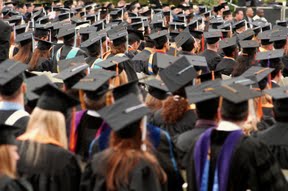After two decades of discouraging reports, the nation’s high school graduation rate showed signs of improvement this year.
Troubling news surrounding unemployment, the housing market and daily fluctuations of the market commanded most people’s attention from 2008 to 2010. Education activists, meanwhile, noted students’ straggling commitment to education and continued their efforts at improving graduation rates. From 2008 to 2010, the number of schools that graduated fewer than 60 percent of their students declined from 1,746 to 1,634, according to Editorial Projects in Education, the parent company of publication Education Week. Further, from 2007, the year the recession began, to 2008, the overall graduation rate for public high school students jumped nearly 3 percentage points.
Although weekly employment statistics are what many leaders point to when charting economic improvement, education activists assert that positive education numbers can be seen as signals that the economy has finally, and firmly, entered a period of renewed growth and stability.
“We are now back to a level of high school completion last seen in the late 1980s — about 72 percent,” said Christopher Swanson, vice president of Editorial Projects in Education. “That’s an important step toward building a well-prepared, 21st century workforce that employers need and demand, but it’s only part of the solution.”
The further solution, according to Swanson, is dedication from learning leaders in corporate America to develop the pipeline of these prospective employees.
“It has become apparent that many of the students who leave high school with a diploma in hand do not have the kinds of high-level skills and preparation that we’d like to see as they continue on to higher education or a career,” he said. “That means the need for significant amounts of remediation to get these young adults up to speed.’”
The responsibilities for that remediation fall to both post-secondary educational institutions and employers.
“Part of what this means for corporate America is that there will likely be need for investment in development to ensure that employees have the kinds of basic skills needed for successful performance in the workforce in general, in addition to more targeted [skills] required for particular occupations,” Swanson said, adding that learning leaders also need to get involved directly where discussions over high school administration take place. “One of the most important things that corporate leaders can do is to engage in the ongoing debates over high school reform. Too often, school reform discussions happen in isolation from other institutional stakeholders.”
The skills incoming employees lack are not always technical; many do not have deeper learning skills necessary to be successful in the workplace.
“Deeper thinking is visual-spatial ability, the hallmark of imagination, creativity and inventiveness,” said Morris Graham, co-author of Executive Thinking: From Brightness to Brilliance. “It is the ability to mentally visualize, invent, construct, deconstruct and manipulate three- and four-dimensional figures holistically in depth. Being able to more rapidly digest competing information, massage and distill it down to the most relevant and substantive elements and simultaneously evaluate the inconsistencies in thinking and actions will allow young people to become better wired to creatively ignite needed changes, improvements and innovations to move our world forward.”
While the importance of deeper thinking and learning is top of mind for employers and those most concerned with educational reform, at the collegiate level there is frustration both among those receiving higher education and those administrating it.
The Pew Research Center released a report in May incorporating two surveys — one of 2,142 adults aged 18 or older; the other of 1,055 college presidents. While 57 percent of those members of the public questioned in the survey said “the higher education system in the United States fails to provide students with good value for the money they and their families spend,” 58 percent of presidents said “public high school students arrive at college less well prepared than their counterparts of a decade ago.”
Meanwhile, the needs of the workplaces college students graduate into have changed.
“The workplace before needed students to have learned a certain amount of information, but after that, it was pretty straightforward what they did,” said Bob Wise, president of education advocacy group the Alliance for Excellent Education. “The workplace needs have gotten much deeper and the learning needs have gotten equally so. Employers are looking for people to come in with a certain amount of knowledge, but they’re looking for — equally important now — someone who comes in who has learned how to learn and can constantly be in a very flexible and changing workplace, constantly adapting and applying deeper learning skills. That wasn’t necessary before and it’s not always being taught now.”
There is a general set of academically focused skills that continue to be essential — strong literacy and numeracy, for example. These are things students have traditionally learned in school. In today’s workforce, there is a set of what are variously called higher-order thinking and deeper learning skills that are increasingly in demand as a foundation of greater innovation. Making sure students have these skills is a learning leader’s responsibility.
Ladan Nikravan is an associate editor of Chief Learning Officer magazine. She can be reached at lnikravan@clomedia.com.















